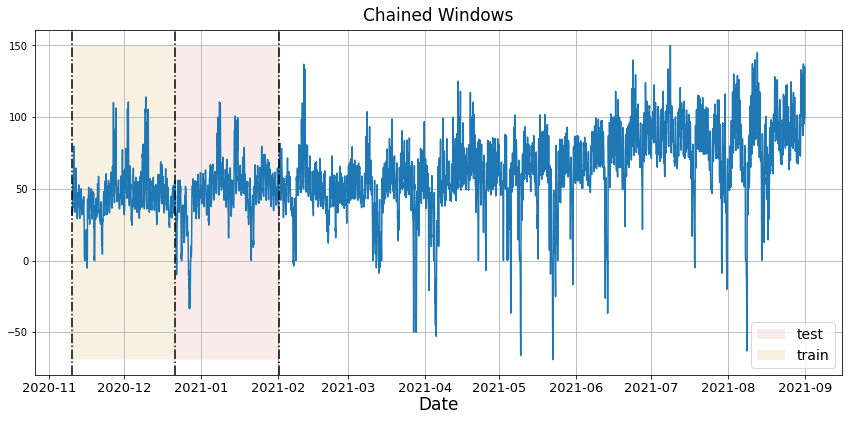In this example, we’ll implement time series cross-validation to evaluate model’s performance.
Prerequesites
This tutorial assumes basic familiarity with MLForecast. For a
minimal example visit the Quick
Start
Introduction
Time series cross-validation is a method for evaluating how a model would have performed in the past. It works by defining a sliding window across the historical data and predicting the period following it. MLForecast has an
implementation of time series cross-validation that is fast and easy to
use. This implementation makes cross-validation an efficient operation,
which makes it less time-consuming. In this notebook, we’ll use it on a
subset of the M4
Competition
hourly dataset.
Outline:
MLForecast has an
implementation of time series cross-validation that is fast and easy to
use. This implementation makes cross-validation an efficient operation,
which makes it less time-consuming. In this notebook, we’ll use it on a
subset of the M4
Competition
hourly dataset.
Outline:
- Install libraries
- Load and explore data
- Train model
- Perform time series cross-validation
- Evaluate results
Tip You can use Colab to run this Notebook interactively
Install libraries
We assume that you haveMLForecast already installed. If not, check
this guide for instructions on how to install
MLForecast
Install the necessary packages with pip install mlforecast.
Load and explore the data
As stated in the introduction, we’ll use the M4 Competition hourly dataset. We’ll first import the data from an URL usingpandas.
| unique_id | ds | y | |
|---|---|---|---|
| 0 | H1 | 1 | 605.0 |
| 1 | H1 | 2 | 586.0 |
| 2 | H1 | 3 | 586.0 |
| 3 | H1 | 4 | 559.0 |
| 4 | H1 | 5 | 511.0 |
MLForecast is a data frame in long
format with
three columns: unique_id, ds and y:
- The
unique_id(string, int, or category) represents an identifier for the series. - The
ds(datestamp or int) column should be either an integer indexing time or a datestamp in format YYYY-MM-DD or YYYY-MM-DD HH:MM:SS. - The
y(numeric) represents the measurement we wish to forecast.

Define forecast object
For this example, we’ll use LightGBM. We first need to import it and then we need to instantiate a new MLForecast object. In this example, we are only usingdifferences and lags to produce
features. See the full
documentation to see all
available features.
Any settings are passed into the constructor. Then you call its fit
method and pass in the historical data frame df.
Perform time series cross-validation
Once theMLForecast object has been instantiated, we can use the
cross_validation
method
For this particular example, we’ll use 3 windows of 24 hours.
unique_id: identifies each time series.ds: datestamp or temporal index.cutoff: the last datestamp or temporal index for then_windows.y: true value"model": columns with the model’s name and fitted value.
| unique_id | ds | cutoff | y | LGBMRegressor | |
|---|---|---|---|---|---|
| 0 | H1 | 677 | 676 | 691.0 | 673.703191 |
| 1 | H1 | 678 | 676 | 618.0 | 552.306270 |
| 2 | H1 | 679 | 676 | 563.0 | 541.778027 |
| 3 | H1 | 680 | 676 | 529.0 | 502.778027 |
| 4 | H1 | 681 | 676 | 504.0 | 480.778027 |

y before said period.
Evaluate results
We can now compute the accuracy of the forecast using an appropiate accuracy metric. Here we’ll use the Root Mean Squared Error (RMSE). To do this, we can useutilsforecast, a Python library developed by Nixtla
that includes a function to compute the RMSE.

